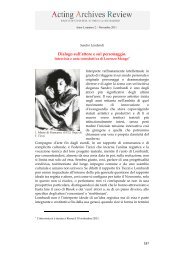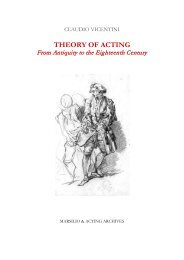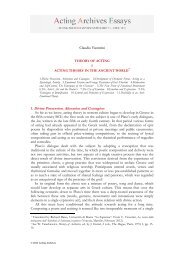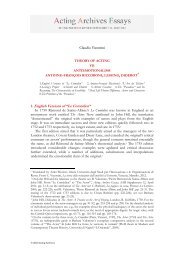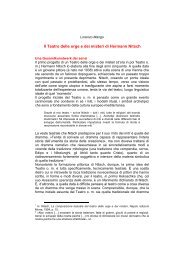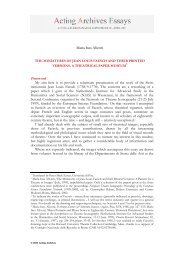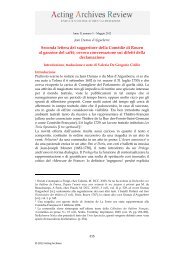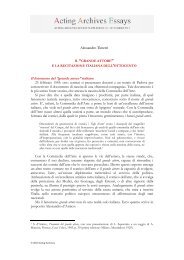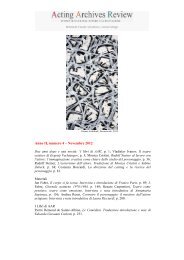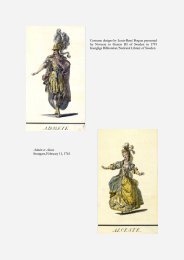Flavia Pappacena_Noverre's Lettres sur la Danse - Acting Archives
Flavia Pappacena_Noverre's Lettres sur la Danse - Acting Archives
Flavia Pappacena_Noverre's Lettres sur la Danse - Acting Archives
You also want an ePaper? Increase the reach of your titles
YUMPU automatically turns print PDFs into web optimized ePapers that Google loves.
AAR <strong>Acting</strong> <strong>Archives</strong> Essays Supplement 9 – April 2011<br />
But if, as he wrote to Voltaire in 1763, in Garrick’s productions the gestures of<br />
the dancer/actor are eloquent because, rather than being studied in front of the<br />
mirror, they spring from the passions, are moulded by feeling and coloured by<br />
veracity; if the action in dance (as in mime) is the art of conveying sentiments and<br />
passions to spectators by means of the actor’s authentic movements, gestures and<br />
face, how can a gesture, as swift and spontaneous as a dart loosed from the soul, be<br />
subjected to rules? Can rules be imposed on mimicry? Should not gestures issue from<br />
the actor’s being and be the faithful interpreters of his impulses? Like Diderot and<br />
Marmontel before him, in 1760 Noverre ruled out any normative operation which<br />
could suffocate the voice of nature and p<strong>la</strong>ce restraints on creativity, insisting on the<br />
impossibility of fixing the whole gamut of moods in a limited repertoire of gestures. 43<br />
In these and simi<strong>la</strong>r considerations from the first edition of the <strong>Lettres</strong>, Noverre<br />
tended to be rather generic, giving undue prominence to his sources – from antiquity<br />
(above all Quintilian), Garrick and theoretical writings on art. He apparently did not<br />
yet possess sufficient experience of “danse en action” to tackle the issues more<br />
directly. The first ballet he presented to be organized in terms of exposition, intrigue<br />
and dénouement, with a narrative structure and without masks, was put on in<br />
November 1757, the year he also began preparing his <strong>Lettres</strong>. Moreover it was only<br />
over the next two years – immediately prior to the publication of his treatise – that<br />
Noverre began to take a serious interest in contemporary discussions of the theatre,<br />
starting to formu<strong>la</strong>te a sort of repertoire of gestures, without however aiming at a<br />
genuine c<strong>la</strong>ssification. In his peremptory dismissal of any suggestion of rules he was<br />
obviously once again attacking the schematic rigidity of academic dance, as well as<br />
rejecting the <strong>la</strong>nguage of mimicry which derived from the commedia dell’arte. It was<br />
only after the experience of Médée (1763), Hypermnestre (1764), La Mort d’Agamemnon<br />
(1772) and Les Horaces et les Curiaces (1774) that his position with respect to mime<br />
changed, as both his chosen texts and the structure of the ballets became more<br />
e<strong>la</strong>borate. The complexity of the individual scenes and the need to anchor the greater<br />
scope and heightened rhythm of the action and give unity to the successive tableaux,<br />
characterising them with coherent gestures and movements, obliged him to structure<br />
a vocabu<strong>la</strong>ry of gesture and, as a result, to make a meticulous study of the individual<br />
roles, experimenting with them himself before he could “teach” them to his dancers.<br />
Thus if in 1760 the problems linked to identifying the appropriate gesture, training<br />
novice dancers and entering into a role are simply enumerated, and in Letter IX he<br />
merely alludes to the need for dancers to be trained in expressing feeling, in Letter<br />
XIII (tome II, 1803), Noverre was able to emphasise the responsibilities of the maître<br />
de ballets with respect to the education of the dancer-actor, his style of acting and the<br />
need always to progress in his art.<br />
If the mechanical part of dance gives the maître de ballets such a lot of trouble and<br />
requires so many formu<strong>la</strong>e, does not the art of gesture and expression demand every bit<br />
as much? Will not rehearsing the movements, giving a lively depiction of the passions,<br />
achieving action dictated by the emotions, the general state of agitation and indeed all<br />
these transitions bring him to a state bordering on delirium? If Agamemnon,<br />
Clytemnester, Achilles and Iphygenia are all on stage together there are four roles which<br />
need to be taught. Each of the actors has his or her own end in view, with opposing<br />
sentiments and different views; each of them has to be animated by the right kind of<br />
43 The various considerations referred to are found in Letters II and X (1760).<br />
12



